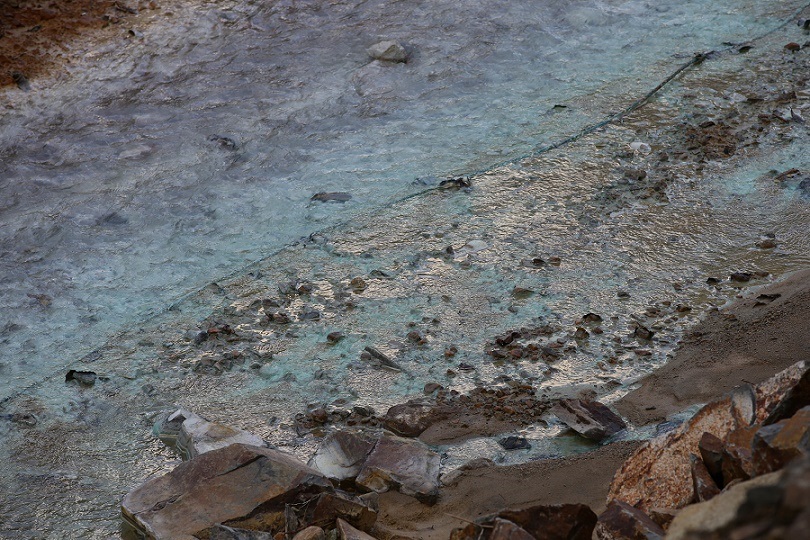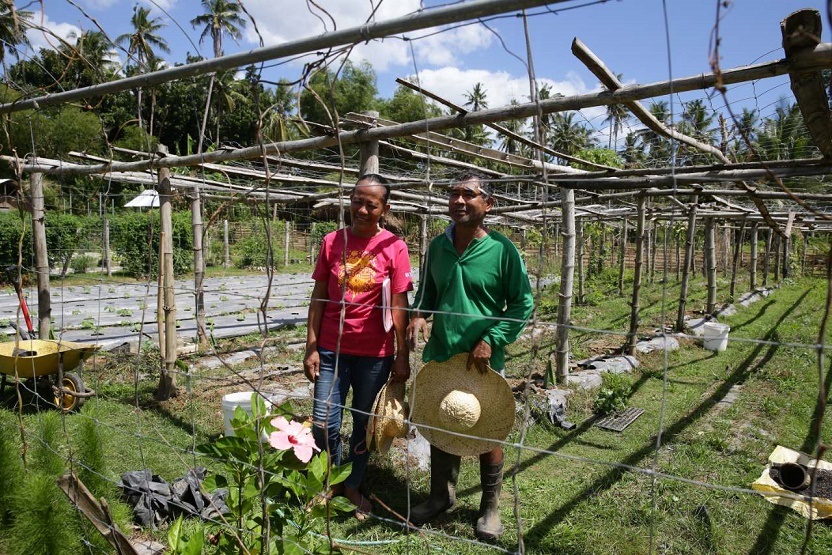(Last of two parts)
Heavy metal runs through Racquel Logatoc’s veins. The 52-year-old village chief of Bocboc, Marinduque suffers from skin irritation, fatigue and body pains. Tests done in 2013 and 2017 detected the harmful substance in her blood. In February, she was back at the Batangas Medical Center for further monitoring.
Logatoc is not alone. Like her, adults and children in Mogpog, Boac, and Sta. Cruz towns of Marinduque, still live with the effects of the disaster that happened 23 years ago.

The Mogpog river was an important part of Bocboc village chief Racquel Logatoc, 53. Doctors have detected a very high metal content in Logatoc.
On March 24, 1996, a fracture in the drainage tunnel of Marcopper Mining Corporation’s Tapian pit spilled more than 1.6 million cubic meters of toxic mine tailings, flooding villages and poisoning the Boac River.
Three years before that, the company’s Maguila-guila siltation dam also burst, flooding the town of Mogpog, where two children drowned in the mine waste. It was a tragedy overshadowed by the Tapian pit mine spill but the mine waste from Maguila-guila was just as toxic that it was an environmental disaster on its own, primarily killing the Mogpog river.
“We used to swim in the river, wash our clothes there, and we even caught shrimps and fishes. The river was wide, and the water was clear and clean,” Logatoc said, sadly looking at what was left of the river.
But even decades before the 1996 mine spill, Marinduque residents have been living amid toxic elements from the mine.
Marcopper Mining Corp. began its mining operations in the Mt. Tapian ore deposit in 1969.
It was the first to use open pit mining in copper concentrate production, according to a briefing paper prepared by Marinduque Representative Lord Allan Jay Velasco.
“Without a proper method of waste disposal, the mine tailings or the waste from Mt. Tapian site were discharged into the Calancan Bay which covered around 8,000 hectares of fishing ground,” it said.
“From 1975 to 1991, the Marcopper-operated mines dumped a total of 200 million tons of toxic tailings into the shallow bay of Calancan,” the paper added.
After depleting Mt. Tapian’s reserve, Marcopper moved to the San Antonio copper mine, three kilometers north of the Mt. Tapian site.
Marcopper claimed the mine tailings that seeped out of the Tapian pit were non-toxic. But Joven Lilles, the province’s environment specialist and one of the first provincial employees to rush to the site when the spillage happened, recalled the stench that could only come from harmful chemicals.
Then and now, a number of residents like Logatoc have suffered from various ailments that doctors attribute to exposure to their toxic environment.
Doctors’ initiatives
Mogpog municipal health officer Dr. Edsel Muhi, an epidemiologist, did a study in 2011 under the Department of Health that established a baseline reference for the level of heavy metals in Mogpog, Boac, and Sta. Cruz, the three towns most affected by Marcopper’s mine wastes.
Six heavy metals were found contaminating the environment and which humans can ingest: lead, arsenic, mercury, cadmium, copper; and chromium or LAMCCC.
Muhi’s study focused on the non-carcinogenic lead and the cancer-causing arsenic. In 2011, Sta. Cruz residents showed the highest arsenic and lead contents in their blood. Calancan Bay, where Marcopper dumped its mine wastes for nearly 30 yearsof its operation, is in Sta. Cruz.
Children with lead in their blood end up with anemia. The metal also targets their central nervous system. “Lead content can also result in developmental delay and congenital problems,” Muhi, a native of Mogpog, said.
Marinduque provincial health officer, Dr. Gerry Caballes, recalled how in 2016, then DOH regional director Dr. Eduardo Janairo, “revived the Marcopper issue and declared Marinduque as a (health) emergency.”
Janairo convened a regional interagency committee for an environmental health assessment in 2017. The provincial health office, together with toxicologists from the East Avenue Medical Center, tested residents for heavy metal content. That was when Bocboc village chief Logatoc learned the heavy metal in her blood system remains high and that she needed regular monitoring.
In 2017, DOH Marinduque’s chief Rowena Garcia did a study that put together a database of residents living near the rivers affected by the mine tailings.
Garcia also established the “telemedicine” system where patients from Marinduque can consult real time with doctors from EAMC and the Batangas Medical Center through a camera and TV.
Heavy metals irritate the skin, with most patients complaining of itch as well as dark spots and white patches on their legs and feet, said Ash Semilla, a nurse at the DOH-Marinduque health office.
Residents end up with skin diseases because they cross the contaminated rivers.
“That’s the only way they could go to work and return home,” Semilla said. She sends photos of patients’ legs and feet to doctors in Manila or Batangas so they have a background on patients’ cases.
With the telemedicine system, patients can consult doctors, avail of laboratory tests and get free medicines through the DOH, the nurse added.
 The water that runs through the Mogpog river has a highacidity level that not even carabaos drink from it.
The water that runs through the Mogpog river has a highacidity level that not even carabaos drink from it.
No rehab for health, environment
Caballes expressed hope the provincial government will continue to support his proposed P20 million water testing laboratory, after years of being told there’s no money for it. A regular monitoring of the 78 water sources in Marinduque was one of Muhi’s recommendations in his 2011 study.
The water testing lab project needs a second bidding after the winning contractor was disqualified, but Caballes had been told the documents for the laboratory “were missing.”
He said doctors will always have their theories on why people get sick, but they need scientific data to back these up.
Caballes wants to investigate if the contaminated environment is linked to the recently monitored clustering of children with delayed development and a number of residents dying of end-stage renal failure.
He said the contaminated environment that has not been rehabilitated remains a threat to residents. Even just regularly breathing air tainted with heavy metals can harm one’s health, experts said.
Law professor Tony La Viña, an environment undersecretary when the 1996 mine spill happened, admitted the national government at that time was too focused on holding Marcopper accountable that it failed to put together a “masterplan to rehabilitate the environment and give livelihood to the people.”
“We didn’t have a systematic approach to really help the affected people in the affected communities,” Caballes said. “We shouldn’t just have made noise. We should also have done something using whatever resources we had then and now.”
At the very least, Marinduque has placed a 50-year moratorium on large- and small-scale mining in the province.
No money for rehab
Caballes and Lilles both pointed out that the national and local governments have said there was not enough money to address the mine spill’s harm to the environment and the people.
While the then Ramos administration commissioned the US Geological Survey study, government was unable to implement the USGS’ detailed recommendations due to lack of funds, Lilles said.
Catherine Coumans, research and Asia-Pacific program coordinator of Mining Watch Canada who had lived in Marinduque before the mine spill, said the worst environmental impact from Marcopper’s mining comes from the mine sites yet to be rehabilitated.
She said the San Antonio pit has been filled up and overtopped with toxic water. The remaining mine wastes of both the San Antonio and Tapian mines are “exposed and contained—in Calancan Bay—where more than 200 million tons of mine waste have destroyed reefs and continue to erode off the causeway in an ongoing slow spill into the ocean.”
“The Mogpog and Boac rivers remain impacted by ongoing toxic inputs from the mine site. These four ecosystems constitute major harm to the small island province as a whole,” Coumans said.

.A resident tries to catch some fish and shrimp from the Boac River. Some marine life have been seen lately but it remains biologically dead.
Twenty-three years and counting
In 2014, the Marinduque provincial government had refused Barrick Gold’s $20 million settlement offer not only because it was not enough to compensate for the environmental damage caused by the Marcopper mine spill. The company, which acquired the remaining common shares of Placer Dome, also wanted thegovernment to waive its accountability and responsibility for the disaster.
Four criminal cases, a civil case, and an administrative case have been filed by the government against Barrick Gold, Marcopper Mining Corp., and Placer Dome, Inc. and their officers since 1996. The cases remain pending in court.
In 2015, a Nevada court ruled it had no jurisdiction over the class suit filed by the Marinduque provincial office against Placer Dome.
Coumans said the court provided the best possible conditions for the case to succeed in Canada, including that Barrick accept the jurisdiction of Canada and for the case not to be sent elsewhere.
“I believe that Barrick Gold remains legally responsible and can be held to account in Canada if the people of Marinduque choose to pursue that course of action,” she said.
On the 23rd anniversary of the Marcopper mine spill, MGB regional director Roland de Jesus said the government will pursue legal action and would stick to filing a case using the Marcopper name, not the new company name, MR Holdings.
Meanwhile, heavy metals continue their poisonous track in the veins of villagers like Logatoc and Marinduque’s future – its children. (With contributions by Nancy Carvajal.)
This story is produced by VERA Files under a project supported by the Internews’ Earth Journalism Network, which aims to empower journalists from developing countries to cover the environment more effectively. )

